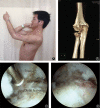Heterotopic Ossification after Arthroscopic Elbow Release
- PMID: 33200575
- PMCID: PMC7670160
- DOI: 10.1111/os.12801
Heterotopic Ossification after Arthroscopic Elbow Release
Abstract
Objectives: To evaluate the incidence and risk factors of heterotopic ossification (HO) after arthroscopic elbow release.
Methods: The present study included 101 elbows, with arthroscopic release performed on 98 patients over the 5-year period from November 2011 to December 2015. Patients were divided into three groups: group 1, with elbow arthritis, including 46 elbows in 43 patients; group 2, with posttraumatic extrinsic elbow stiffness (without intraarticular adhesion), including 23 elbows in 23 patients; and group 3, with intrinsic contractures (with intraarticular adhesion), including 32 elbows in 32 patients. Arthroscopic elbow release was performed under general anesthesia. For intrinsic stiffness, a radiofrequency device was applied to release intraarticular scar tissue and create work space, which was rarely necessary in groups 1 and 2. In the postoperative period, X-rays and CT scans were assessed at follow up to determine if there was HO formation, which was diagnosed when new calcifications were identified. The functional recovery was evaluated by comparing the range of motion (ROM) and pain relief preoperativley and postoperatively in each group. Other complications were also assessed postoperatively.
Results: The patients' mean age was 38.6 years (range, 12-66), with 57 males and 41 females. Mean follow-up was 21 months (range, 4-56). The active ROM and Mayo elbow performance index (MEPS) were improved from 93° ± 8.3° to 126° ± 12.4° (P < 0.05) and 71.4 ± 7.6 to 91.3 ± 8.7 (P < 0.001) in group 1, 66° ± 10.3° to 121° ± 10.7° (P < 0.005) and 65.6 ± 9.2 to 93.5 ± 11.2 (P < 0.05) in group 2, and 46° ± 6.7° to 91° ± 11.1° (P < 0.001) and 52.3 ± 6.4 to 80.6 ± 9.4 (P < 0.005) in group 3. HO developed in 25/101 cases (25%) and 4 patients with severe cases underwent repeat surgery. Those in group 1 were primarily arthritis patients; there were 3 out 46 cases with minor HO evident on X-ray. In group 2, 1/23 had minor HO. In group 3, 21/32 patients had HO; 4 cases were considered severe, 4 were considered moderate, and 13 were considered minor. The average flexion-extension arc was improved by 47° at the last follow up. Other postoperative complications included 8 cases of prolonged drainage from portal sites, 17 transient nerve palsies, 1 permanent radial nerve injury, and 1 patient who developed delayed-onset ulnar neuritis. This patient was fully recovered 5 months after surgery.
Conclusions: The high incidence of HO formation after arthroscopic elbow release may relate to improper application of a radiofrequency device. Minimizing thermal injury from these radiofrequency devices could reduce HO formation and improve postoperative functional recovery.
Keywords: Elbow arthroscopy; Heterotopic ossification; Stiff elbow.
© 2020 The Authors. Orthopaedic Surgery published by Chinese Orthopaedic Association and John Wiley & Sons Australia, Ltd.
Figures




Similar articles
-
Arthroscopic Treatment of Posttraumatic Elbow Stiffness Due to Soft Tissue Problems.Orthop Surg. 2020 Oct;12(5):1464-1470. doi: 10.1111/os.12787. Epub 2020 Oct 4. Orthop Surg. 2020. PMID: 33015918 Free PMC article.
-
Safety of Arthroscopic Versus Open or Combined Heterotopic Ossification Removal Around the Elbow.Arthroscopy. 2020 Feb;36(2):422-430. doi: 10.1016/j.arthro.2019.09.010. Epub 2019 Dec 20. Arthroscopy. 2020. PMID: 31870750
-
Heterotopic ossification of the elbow treated with surgical resection: risk factors, bony ankylosis, and complications.Clin Orthop Relat Res. 2014 Jul;472(7):2269-75. doi: 10.1007/s11999-014-3591-0. Epub 2014 Apr 8. Clin Orthop Relat Res. 2014. PMID: 24711127 Free PMC article.
-
Heterotopic Ossification After the Arthroscopic Treatment of Lateral Epicondylitis.Hand (N Y). 2017 May;12(3):NP32-NP36. doi: 10.1177/1558944716668844. Hand (N Y). 2017. PMID: 28453354 Free PMC article. Review.
-
The stiff elbow.Bull NYU Hosp Jt Dis. 2007;65(1):24-8. Bull NYU Hosp Jt Dis. 2007. PMID: 17539758 Review.
Cited by
-
Complications of Elbow Arthroscopic Surgery: A Systematic Review and Meta-analysis.Orthop J Sports Med. 2022 Nov 30;10(11):23259671221137863. doi: 10.1177/23259671221137863. eCollection 2022 Nov. Orthop J Sports Med. 2022. PMID: 36479463 Free PMC article. Review.
-
Application of ultrasound in avoiding radial nerve injury during elbow arthroscopy: a retrospective follow-up study.BMC Musculoskelet Disord. 2022 Dec 24;23(1):1126. doi: 10.1186/s12891-022-06109-8. BMC Musculoskelet Disord. 2022. PMID: 36566206 Free PMC article.
-
Shoulder and Elbow Surgery Special Issue.Orthop Surg. 2020 Oct;12(5):1337-1339. doi: 10.1111/os.12813. Orthop Surg. 2020. PMID: 33200573 Free PMC article. No abstract available.
-
Heterotopic Ossification After Arthroscopic Procedures: A Scoping Review of the Literature.Orthop J Sports Med. 2022 Jan 18;10(1):23259671211060040. doi: 10.1177/23259671211060040. eCollection 2022 Jan. Orthop J Sports Med. 2022. PMID: 35071654 Free PMC article.
-
Anterior Capsulectomy Through Humeral Fenestration in Arthroscopic Arthrolysis for Elbow Stiffness Is Safe and Effective.Arthrosc Sports Med Rehabil. 2024 Oct 15;7(1):101029. doi: 10.1016/j.asmr.2024.101029. eCollection 2025 Feb. Arthrosc Sports Med Rehabil. 2024. PMID: 40041832 Free PMC article.
References
-
- O'Driscoll SW. Arthroscopic treatment for osteoarthritis of the elbow. Orthop Clin North Am, 1995, 26: 691–706. - PubMed
-
- Savoie FH 3rd, Nunley PD, Field LD. Arthroscopic management of the arthritic elbow: indications, technique, and results. J Shoulder Elbow Surg, 1999, 8: 214–219. - PubMed
-
- Jones GS, Savoie FH 3rd. Arthroscopic capsular release of flexion contractures (arthrofibrosis) of the elbow. Art Ther, 1993, 9: 277–283. - PubMed
-
- Ball CM, Meunier M, Galatz LM, Calfee R, Yamaguchi K. Arthroscopic treatment of post‐traumatic elbow contracture. J Shoulder Elbow Surg, 2002, 11: 624–629. - PubMed
-
- Steinmann SP, King GJ, Savoie FH 3rd. Arthroscopic treatment of the arthritic elbow instructional course lecture. J Bone Joint Surg Am, 2005, 87: 2114–2121. - PubMed
MeSH terms
Grants and funding
LinkOut - more resources
Full Text Sources
Medical

